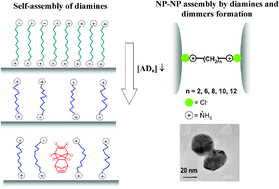Self-assembly of α,ω-aliphatic diamines on Ag nanoparticles as an effective localized surface plasmon nanosensor based in interparticle hot spots
Abstract
The

- This article is part of the themed collections: New frontiers in Surface-Enhanced Raman Scattering and Web Collection: Surface-Enhanced Raman Scattering (SERS)

 Please wait while we load your content...
Please wait while we load your content...